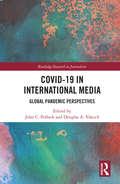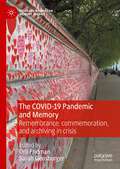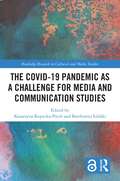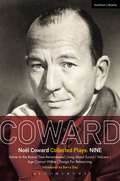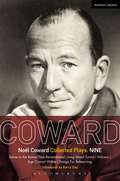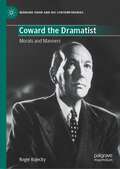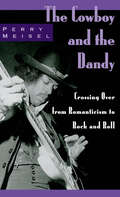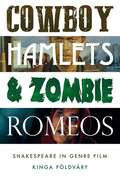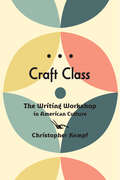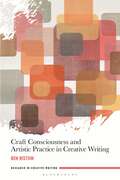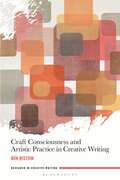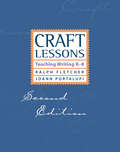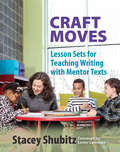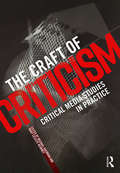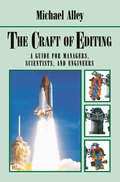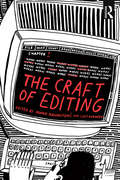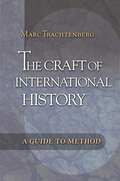- Table View
- List View
COVID-19 in International Media: Global Pandemic Perspectives (Routledge Research in Journalism)
by John C. Pollock Douglas A. VakochCovid-19 in International Media: Global Pandemic Responses is one of the first books uniting an international team of scholars to investigate how media address critical social, political, and health issues connected to the 2020-21 COVID-19 outbreak. The book evaluates unique civic challenges, responsibilities, and opportunities for media worldwide, exploring pandemic social norms that media promote or discourage, and how media serve as instruments of social control and resistance, or of cooperation and representation. These chapters raise significant questions about the roles mainstream or citizen journalists or netizens play or ought to play, enlightening audiences successfully about scientific information on COVID-19 in a pandemic that magnifies social inequality and unequal access to health care, challenging popular beliefs about health and disease prevention and the role of government while the entire world pays close attention. This book will be of interest to students and faculty of communication studies and journalism, departments of public health, sociology, and social marketing.
The COVID-19 Pandemic and Memory: Remembrance, commemoration, and archiving in crisis (Palgrave Macmillan Memory Studies)
by Orli Fridman Sarah GensburgerThis book offers a platform for the analysis of commemorative and archiving practices as they were shaped, expanded, and developed during the Covid-19 lockdown periods in 2020 and the years that followed. By offering an extensive global view of these changes as well as of the continuities that went with them, the book enters a dialogue with what has emerged as an initial response to the pandemic and the ways in which it has affected memory and commemoration.The book aims to critically and empirically engage with this abundance of memory to understand both memorialization of the pandemic and commemoration during the pandemic: what happened then to commemorative practices and rituals around the world? How has the Covid-19 pandemic been archived and remembered? What will remembering it actually entail, and what will it mean in the future? Where did the Covid memory boom come from? Who was behind it, how did it emerge, and in what socialconfigurations did it evolve?
The Covid-19 Pandemic as a Challenge for Media and Communication Studies (Routledge Research in Cultural and Media Studies)
by Katarzyna Kopecka-PiechThis truly interdisciplinary volume brings together a diverse group of scholars to explore changes in the significance of media and communication in the era of pandemic. The book answers two interrelated questions: how media and communication reality changed during the first wave of the COVID-19 pandemic, and how media and communication were effectively studied during this time. The book presents changes in media and communication in three areas: media production, media content, and media usage contexts. It then describes the theoretical and practical, methodological, technical, organizational, and ethical challenges in conducting research in circumstances of sudden change in research conditions, emergency situations and developing crises. Drawing on various theoretical studies and empirical research, the volume illustrates the principles and results of applying diverse research methods to the changing role of media in a pandemic and offers good practices and guidance to address the problems in implementing research projects in a time of sudden difficulties and challenges. This diverse and interdisciplinary book will be of significance to scholars and researchers in media studies, communication studies, research methods, sociology, anthropology, and cultural studies.
The Covid-19 Pandemic as a Challenge for Media and Communication Studies (Routledge Research in Cultural and Media Studies)
by Katarzyna Kopecka-Piech Bart 322 Omiej 321 ÓdzkiThis truly interdisciplinary volume brings together a diverse group of scholars to explore changes in the significance of media and communication in the era of pandemic. The book answers two interrelated questions: how media and communication reality changed during the first wave of the COVID-19 pandemic, and how media and communication were effectively studied during this time. The book presents changes in media and communication in three areas: media production, media content, and media usage contexts. It then describes the theoretical and practical, methodological, technical, organizational, and ethical challenges in conducting research in circumstances of sudden change in research conditions, emergency situations and developing crises. Drawing on various theoretical studies and empirical research, the volume illustrates the principles and results of applying diverse research methods to the changing role of media in a pandemic and offers good practices and guidance to address the problems in implementing research projects in a time of sudden difficulties and challenges. This diverse and interdisciplinary book will be of significance to scholars and researchers in media studies, communication studies, research methods, sociology, anthropology, and cultural studies.
Coward Plays: Salute to the Brave/Time Remembered; Long Island Sound; Volcano; Age Cannot Wither; Design For Rehearsing (World Classics)
by Noël CowardCoward Plays: 9 offers up a fascinating selection of Noël Coward's lesser-known works. Salute to the Brave/Time Remembered (1940) follows Leila Heseldyne after she has fled to America, leaving a war-torn Britain and her husband behind; Long Island Sound(1947) sees a writer coerced into a riotous flock of high flying society people with turbulent results; and Volcano (1957) depicts a volcanic eruption as it punctuates the dubious conduct of six individuals on a fictional South Sea island. This volume also includes Design for Rehearsing (1933) was Coward's private satire on the way he , Alfred Lunt and Lynn Fontanne worked on Design for Living. Age Cannot Wither (1967), Coward's last and unfinished play completes the collection as it portrays the boozy reunion of three women in their sixties, who meet without fail every year to reminisce. Together, these works offer a new and intriguing insight into Coward the playwright and his oeuvre that extends well beyond his most well-known works such as Private Lives, Blithe Spirit and Hay Fever. The volume is introduced by Coward expert and scholar Barry Day.
Coward Plays: Salute to the Brave/Time Remembered; Long Island Sound; Volcano; Age Cannot Wither; Design For Rehearsing (World Classics)
by Noël CowardCoward Plays: 9 offers up a fascinating selection of Noël Coward's lesser-known works. Salute to the Brave/Time Remembered (1940) follows Leila Heseldyne after she has fled to America, leaving a war-torn Britain and her husband behind; Long Island Sound(1947) sees a writer coerced into a riotous flock of high flying society people with turbulent results; and Volcano (1957) depicts a volcanic eruption as it punctuates the dubious conduct of six individuals on a fictional South Sea island. This volume also includes Design for Rehearsing (1933) was Coward's private satire on the way he , Alfred Lunt and Lynn Fontanne worked on Design for Living. Age Cannot Wither (1967), Coward's last and unfinished play completes the collection as it portrays the boozy reunion of three women in their sixties, who meet without fail every year to reminisce. Together, these works offer a new and intriguing insight into Coward the playwright and his oeuvre that extends well beyond his most well-known works such as Private Lives, Blithe Spirit and Hay Fever. The volume is introduced by Coward expert and scholar Barry Day.
Coward the Dramatist: Morals and Manners (Bernard Shaw and His Contemporaries)
by Roger KojeckyDiscussions of Coward’s achievement in the theatre between 1920 and 1966 have tended to stay with the colourful biography. The more analytical literary approach adopted here places Coward’s success in its wider theatrical context, making the connections with the work of other dramatists. He developed his technique according to what worked with theatre audiences. Taking up the well-made play, he brought in a more colloquial dialogue, explored, for instance, the morality and psychology of marriage and free love, and frequently exploited the dramatic possibilities of characters grouped into two camps. The book considers both the ‘pleasant’ and ‘unpleasant’ plays (to use the Shavian terms), and the episodic patriotic plays. It Includes Coward’s ambivalent approach to the ‘theatre of war’ in the 20th century. (123)
The Cowboy and the Dandy: Crossing Over from Romanticism to Rock and Roll
by Perry MeiselWhat is rock and roll and where does it come from? In this adventurous new study of music, literature, and culture, Perry Meisel shows how rock and roll joins Romanticism and the blues tradition by focusing on the preoccupation with boundaries that are common to both--the boundaries between freedom and irony, country and city, and cowboy and dandy. Meisel traces the emergence of rock and roll out of jazz and Romantic culture alike as he examines, in a series of juxtaposed chapters, rhythm and blues, Emerson and the cowboy, urban blues, the dandy and psychedelia, Willa Cather, Miles Davis, Virginia Woolf, and 1960s rock. In the process, Meisel shows how the presumable difference between high and mass or pop culture disappears when both turn out to have similar structures. He also reveals how canons emerge inevitably within all traditions rather than being imposed upon them from without.
Cowboy Hamlets and zombie Romeos: Shakespeare in genre film (Manchester University Press)
by Kinga FöldváryThe book presents a systematic method of interpreting Shakespeare film adaptations based on their cinematic genres. Its approach is both scholarly and reader-friendly, and its subject is fundamentally interdisciplinary, combining the findings of Shakespeare scholarship with film and media studies, particularly genre theory. The book is organised into six large chapters, discussing films that form broad generic groups. Part I looks at three genres from the classical Hollywood era (western, melodrama and gangster-noir), while Part II deals with three contemporary blockbuster genres (teen film, undead horror and biopic). Beside a few better-known examples of mainstream cinema, the volume also highlights the Shakespearean elements in several nearly forgotten films, bringing them back to critical attention.
Cowboy Hamlets and zombie Romeos: Shakespeare in genre film (Manchester University Press)
by Kinga FöldváryThe book presents a systematic method of interpreting Shakespeare film adaptations based on their cinematic genres. Its approach is both scholarly and reader-friendly, and its subject is fundamentally interdisciplinary, combining the findings of Shakespeare scholarship with film and media studies, particularly genre theory. The book is organised into six large chapters, discussing films that form broad generic groups. Part I looks at three genres from the classical Hollywood era (western, melodrama and gangster-noir), while Part II deals with three contemporary blockbuster genres (teen film, undead horror and biopic). Beside a few better-known examples of mainstream cinema, the volume also highlights the Shakespearean elements in several nearly forgotten films, bringing them back to critical attention.
Cowley's Essays
by Abraham CowleyThe calm spirit of Cowley's "Essays" was in all his life. As he tells us in his Essay "On Myself," even when he was a very young boy at school, instead of running about on holidays and playing with his fellows, he was wont to steal from them and walk into the fields, either alone with a book or with some one companion, if he could find any of the same temper.
Craft Class: The Writing Workshop in American Culture
by Christopher KempfThe hidden history of the creative writing workshop and the socioeconomic consequences of the craft labor metaphor.In a letter dated September 1, 1912, drama professor George Pierce Baker recommended the term "workshop" for an experimental course in playwriting he had been planning with former students at Harvard and Radcliffe. This was the first time that term, now ubiquitous, was used in the context of creative writing pedagogy. Today, the MFA (master of fine arts) industry is a booming one, with more than 200 programs and thousands of residencies and conferences for aspiring writers nationwide. Almost all of these offerings operate on the workshop model.In Craft Class, Christopher Kempf argues that the primary institutional form of creative writing studies, the workshop, has remained invisible before our scholarly eyes. While Baker and others marshaled craft toward economic critique, craft pedagogies consolidated the authority of elite educational institutions as the MFA industry grew. Transcoding professional-managerial soft skills—linguistic facility, social and emotional discernment, symbolic fluency—in the language of manual labor, the workshop nostalgically invokes practices that the university itself has rendered obsolete. The workshop poem or short story thus shares discursive space with the craft IPA or hand-loomed Pottery Barn rug—a space in which one economic practice rewrites itself in the language of another, just as right-wing corporatism continuously rewrites itself in the language of populism.Delineating an arc that extends from Boston's fin de siècle Society of Arts and Crafts through 1930s proletarian workshops to the pedagogies of Black Mountain College and the postwar MFA, Craft Class reveals how present-day creative writing restructures transhistorical questions of labor, education, and aesthetic and economic production. With the rise of the workshop in American culture, Kempf shows, manual and mental labor have been welded together like steel plates. What fissures does that weld seal shut? And on whose behalf does the poet punch in?
Craft Class: The Writing Workshop in American Culture
by Christopher KempfThe hidden history of the creative writing workshop and the socioeconomic consequences of the craft labor metaphor.In a letter dated September 1, 1912, drama professor George Pierce Baker recommended the term "workshop" for an experimental course in playwriting he had been planning with former students at Harvard and Radcliffe. This was the first time that term, now ubiquitous, was used in the context of creative writing pedagogy. Today, the MFA (master of fine arts) industry is a booming one, with more than 200 programs and thousands of residencies and conferences for aspiring writers nationwide. Almost all of these offerings operate on the workshop model.In Craft Class, Christopher Kempf argues that the primary institutional form of creative writing studies, the workshop, has remained invisible before our scholarly eyes. While Baker and others marshaled craft toward economic critique, craft pedagogies consolidated the authority of elite educational institutions as the MFA industry grew. Transcoding professional-managerial soft skills—linguistic facility, social and emotional discernment, symbolic fluency—in the language of manual labor, the workshop nostalgically invokes practices that the university itself has rendered obsolete. The workshop poem or short story thus shares discursive space with the craft IPA or hand-loomed Pottery Barn rug—a space in which one economic practice rewrites itself in the language of another, just as right-wing corporatism continuously rewrites itself in the language of populism.Delineating an arc that extends from Boston's fin de siècle Society of Arts and Crafts through 1930s proletarian workshops to the pedagogies of Black Mountain College and the postwar MFA, Craft Class reveals how present-day creative writing restructures transhistorical questions of labor, education, and aesthetic and economic production. With the rise of the workshop in American culture, Kempf shows, manual and mental labor have been welded together like steel plates. What fissures does that weld seal shut? And on whose behalf does the poet punch in?
Craft Consciousness and Artistic Practice in Creative Writing (Research in Creative Writing)
by Ben RistowCraft lives inside the artist, and it operates in the mind, not in standards or techniques. Creative writers navigate thresholds in consciousness as they develop their arts practice. Craft Consciousness and Artistic Practice in Creative Writing explores what it is to be an artist as it traces radical, feminist, and culturally embedded traditions in craft. The new term "craft consciousness" identifies the nexus from which writers explore making processes and practitioner knowledge. Writers, as with all artists, create and reimagine themselves anew, and it is in this perpetual state of becoming that they find ways to enlarge their sense of artistry through an exploration of forms, processes, and mediums beyond the written word.For writers, this book initiates a reexamination of the mission of creative writing through disrupting patriarchal, racist, colonialist, ableist, and capitalist associations with dominant craft. Drawing from twenty-five interviews with living artists outside of writing and in a host of fields from conceptual art to leatherwork and dance, the book shines a light on how the processes associated with craft are embodied. Craft is an internalized matrix; it need not be commodified for the marketplace or codified in the standards necessitated by institutions of higher education. By redesigning writing workshops and MFA/PhD programs through craft consciousness, new potentials and collaborations emerge, and it becomes more conceivable to imagine dynamic, inclusive relationships between writers, scientists, and other artists.
Craft Consciousness and Artistic Practice in Creative Writing (Research in Creative Writing)
by Ben RistowCraft lives inside the artist, and it operates in the mind, not in standards or techniques. Creative writers navigate thresholds in consciousness as they develop their arts practice. Craft Consciousness and Artistic Practice in Creative Writing explores what it is to be an artist as it traces radical, feminist, and culturally embedded traditions in craft. The new term "craft consciousness" identifies the nexus from which writers explore making processes and practitioner knowledge. Writers, as with all artists, create and reimagine themselves anew, and it is in this perpetual state of becoming that they find ways to enlarge their sense of artistry through an exploration of forms, processes, and mediums beyond the written word.For writers, this book initiates a reexamination of the mission of creative writing through disrupting patriarchal, racist, colonialist, ableist, and capitalist associations with dominant craft. Drawing from twenty-five interviews with living artists outside of writing and in a host of fields from conceptual art to leatherwork and dance, the book shines a light on how the processes associated with craft are embodied. Craft is an internalized matrix; it need not be commodified for the marketplace or codified in the standards necessitated by institutions of higher education. By redesigning writing workshops and MFA/PhD programs through craft consciousness, new potentials and collaborations emerge, and it becomes more conceivable to imagine dynamic, inclusive relationships between writers, scientists, and other artists.
Craft Lessons: Teaching Writing K-8
by Ralph Fletcher JoAnn PortalupiSince its publication in 1998 Craft Lessons has become a staple in the writing classroom of both new and experienced teachers. Authors Ralph Fletcher and JoAnn Portalupi recognized the need for a succinct resource and teamed together to write the second edition of Craft Lessons: Teaching Writing K-8 . Teachers pressed for time will appreciate the practical lessons and instructional language geared to three grade level groupings: K-2, 3-4, and 5-8. This edition includes: 17 brand new lessons; mini lessons designed from teachers&’ comments about what is observed students&’ writing Revisions to other craft lessons and the resource materials sections have been expanded New ways to approach teaching using elements of craft and the reading-writing connection A subject index to find specific craft lessons with ease The authors&’ thoughts about how craft lessons fit into their newest thinking about the qualities of writing: Ideas, Design, Language, and Presentation The 95 lessons in this book provide a wealth of information for teaching leads, character, endings, stronger verbs, and much more. This new edition reestablishes Craft Lessons as the crucial desert island book for harried writing teachers everywhere
Craft Lessons: Teaching Writing K-8
by Ralph Fletcher JoAnn PortalupiSince its publication in 1998 Craft Lessons has become a staple in the writing classroom of both new and experienced teachers. Authors Ralph Fletcher and JoAnn Portalupi recognized the need for a succinct resource and teamed together to write the second edition of Craft Lessons: Teaching Writing K-8 . Teachers pressed for time will appreciate the practical lessons and instructional language geared to three grade level groupings: K-2, 3-4, and 5-8. This edition includes: 17 brand new lessons; mini lessons designed from teachers&’ comments about what is observed students&’ writing Revisions to other craft lessons and the resource materials sections have been expanded New ways to approach teaching using elements of craft and the reading-writing connection A subject index to find specific craft lessons with ease The authors&’ thoughts about how craft lessons fit into their newest thinking about the qualities of writing: Ideas, Design, Language, and Presentation The 95 lessons in this book provide a wealth of information for teaching leads, character, endings, stronger verbs, and much more. This new edition reestablishes Craft Lessons as the crucial desert island book for harried writing teachers everywhere
Craft Moves: Lesson Sets for Teaching Writing with Mentor Texts
by Stacey ShubitzHow do you choose mentor texts for your students? How do you mine them for the craft lessons you want your students to learn?In Craft Moves: Lesson Sets for Teaching Writing with Mentor Texts , Stacey Shubitz, co-founder of the Two Writing Teachers website, usestwenty recently published picture books to createmore than 180 lessons to teach various craft moves that will help your students become better writers.Each of the 184 lessons in the book includes a publisher's summary, a rationale or explanation of the craft move demonstrated in the book, and a procedure that takes teachers and students back into the mentor text to deepen their understanding of the selected craft move. A step-by-step guide demonstrates how to analyze a picture book for multiple craft moves.Shubitzintroduces picture books as teaching tools and offers ways to integrate them into your curriculum and classroom discussions. She then shares different routines and classroom procedures designed to help students focus on their writing during the writer's workshop as well as focusing how teachers can prepare for small group instruction.Using picture books as mentor texts will help your students not only read as writers and write with joy but also become writers who can effectively communicate meaning, structure their writing, write with detail, and give their writing their own unique voice.
Craft Moves: Lesson Sets for Teaching Writing with Mentor Texts
by Stacey ShubitzHow do you choose mentor texts for your students? How do you mine them for the craft lessons you want your students to learn?In Craft Moves: Lesson Sets for Teaching Writing with Mentor Texts , Stacey Shubitz, co-founder of the Two Writing Teachers website, usestwenty recently published picture books to createmore than 180 lessons to teach various craft moves that will help your students become better writers.Each of the 184 lessons in the book includes a publisher's summary, a rationale or explanation of the craft move demonstrated in the book, and a procedure that takes teachers and students back into the mentor text to deepen their understanding of the selected craft move. A step-by-step guide demonstrates how to analyze a picture book for multiple craft moves.Shubitzintroduces picture books as teaching tools and offers ways to integrate them into your curriculum and classroom discussions. She then shares different routines and classroom procedures designed to help students focus on their writing during the writer's workshop as well as focusing how teachers can prepare for small group instruction.Using picture books as mentor texts will help your students not only read as writers and write with joy but also become writers who can effectively communicate meaning, structure their writing, write with detail, and give their writing their own unique voice.
The Craft of Criticism: Critical Media Studies in Practice
by Michael Kackman Mary Celeste KearneyWith contributions from 30 leading media scholars, this collection provides a comprehensive overview of the main methodologies of critical media studies. Chapters address various methods of textual analysis, as well as reception studies, policy, production studies, and contextual, multi-method approaches, like intertextuality and cultural geography. Film and television are at the heart of the collection, which also addresses emergent technologies and new research tools in such areas as software studies, gaming, and digital humanities. Each chapter includes an intellectual history of a particular method or approach, a discussion of why and how it was used to study a particular medium or media, relevant examples of influential work in the area, and an in-depth review of a case study drawn from the author's own research. Together, the chapters in this collection give media critics a complete toolbox of essential critical media studies methodologies.
The Craft of Criticism: Critical Media Studies in Practice
by Mary Celeste Kearney Michael KackmanWith contributions from 30 leading media scholars, this collection provides a comprehensive overview of the main methodologies of critical media studies. Chapters address various methods of textual analysis, as well as reception studies, policy, production studies, and contextual, multi-method approaches, like intertextuality and cultural geography. Film and television are at the heart of the collection, which also addresses emergent technologies and new research tools in such areas as software studies, gaming, and digital humanities. Each chapter includes an intellectual history of a particular method or approach, a discussion of why and how it was used to study a particular medium or media, relevant examples of influential work in the area, and an in-depth review of a case study drawn from the author's own research. Together, the chapters in this collection give media critics a complete toolbox of essential critical media studies methodologies.
The Craft of Editing: A Guide for Managers, Scientists, and Engineers
by Michael AlleyDesigned for all those who deal with scientific and technical writing by others in universities, government labs, businesses, or engineering firms, this book helps readers become more effective and more efficient at editing the proposals, theses, journal articles, and reports that cross their desks and which need approving, grading, or reviewing. Written by the author of the best-selling "Craft of Scientific Writing", the guide deals with the subject in a refreshing way and includes a large number of enlightening examples and stories.
The Craft of Editing
by Adnan Mahmutović Lucy DurneenThe Craft of Editing offers a rare insight into the unique dynamic between author and editor. In this illuminating book, Adnan Mahmutović and Lucy Durneen lead a cohort of industry experts to bring transparency to the mystique that often surrounds the craft and practice of editing. Using genuine case studies from published works – including annotated manuscripts – this book prepares writers for potential dialogue and critique from editors. The Craft of Editing follows the journey from rough draft to publication, an essential part of any writing experience, while showing the singular and authentic approach each editor takes. Using original pitches, debates, emails, and instant messages to shed light on the collaboration between authors and editors, The Craft of Editing is an indispensable tool to creative writers and students alike.
The Craft of Editing
by Adnan Mahmutović Lucy DurneenThe Craft of Editing offers a rare insight into the unique dynamic between author and editor. In this illuminating book, Adnan Mahmutović and Lucy Durneen lead a cohort of industry experts to bring transparency to the mystique that often surrounds the craft and practice of editing. Using genuine case studies from published works – including annotated manuscripts – this book prepares writers for potential dialogue and critique from editors. The Craft of Editing follows the journey from rough draft to publication, an essential part of any writing experience, while showing the singular and authentic approach each editor takes. Using original pitches, debates, emails, and instant messages to shed light on the collaboration between authors and editors, The Craft of Editing is an indispensable tool to creative writers and students alike.
The Craft of International History: A Guide to Method
by Marc TrachtenbergThis is a practical guide to the historical study of international politics. The focus is on the nuts and bolts of historical research--that is, on how to use original sources, analyze and interpret historical works, and actually write a work of history. Two appendixes provide sources sure to be indispensable for anyone doing research in this area. The book does not simply lay down precepts. It presents examples drawn from the author's more than forty years' experience as a working historian. One important chapter, dealing with America's road to war in 1941, shows in unprecedented detail how an interpretation of a major historical issue can be developed. The aim throughout is to throw open the doors of the workshop so that young scholars, both historians and political scientists, can see the sort of thought processes the historian goes through before he or she puts anything on paper. Filled with valuable examples, this is a book anyone serious about conducting historical research will want to have on the bookshelf.
